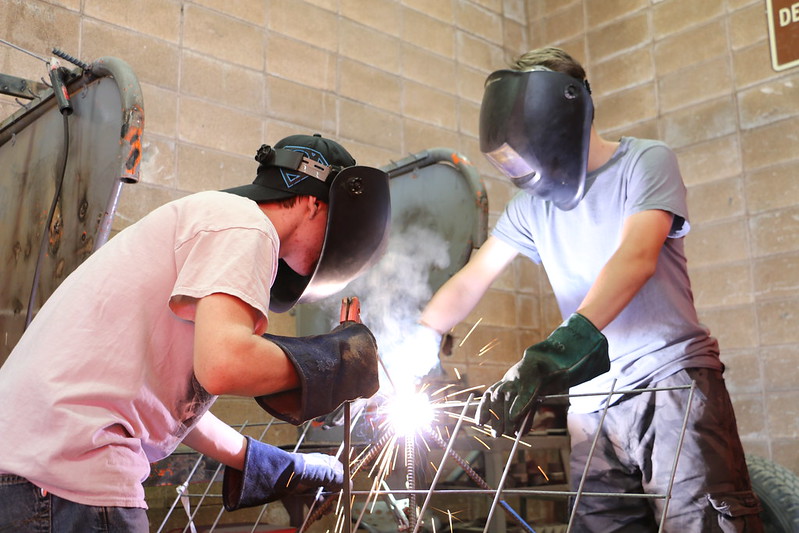
In these postings, we’ve looked at how governments recognized problems or needs, eventually accepted responsibility for solving them, and gradually learned how to do a good job of providing a service or reducing a threat. But vocational education (also called career and technical education) isn’t one of these success stories. It is, at best, a partial success.
Before we get to the problems, though, a definition: Post-secondary vocation education teaches skills that can be learned in less than four years and offer a path to a well-paying job. In one form or another, such training is available in every state through technical schools or community colleges, or as part of regular two- or four-year colleges. Given the pace of change in business, it’s not surprising to learn that VocEd covers a lot of ground these days, from graphic design and computer technology to plumbing and welding. Culinary institutions, barber schools, some nursing programs, and most auto mechanics schools also fit under the umbrella.
That’s the post-secondary part of vocational education. There is also a high school version of VocEd that does pretty much the same thing, teaching carpentry skills, auto repair, and cosmetology to children who do not have an interest in college. (To see how impressive some of these schools can be, take a look the Boston area’s Minuteman Regional Vocational Technical High School.)
If that’s not confusing enough, there are hundreds of thousands of high school students who attend post-secondary technical schools under “dual enrollment” programs that allow them to earn credit for high school courses and VocEd courses at the same time. So these students are taking secondary and post-secondary classes at the same time. Here’s how it works in one state, Georgia.
At first glance, then, there appears to be an impressive network of vocational and technical education. So why is this only a partial success? Because there’s far more demand for this education than there is supply by public institutions.
In Connecticut, for instance, there are about 3,000 seats in its two-year public technical schools. In recent years, 6,000 students applied for these seats.
And it’s easy to see why young people want the training. Jobs that pay $35,000 or more a year (that’s about $17 an hour, which is at the low end of a “living wage”), are drying up for workers with a high school education or less. But these jobs—and those paying more—are still available for workers with community college or trade-school degrees and certificates. In fact, jobs in these “middle-skills” categories grew by 29 percent from 1991 to 2016.
So, there’s great demand and significant rewards for those with training, but too few slots in public VocEd institutions. The results? One is a shortage of skilled workers. Before the 2020 pandemic, 70 percent of construction companies nationwide reported having trouble finding qualified electricians, carpenters, plumbers and so on. There are similar shortages in health care and the trucking industry, skills routinely taught in public VocEd schools.
The other result has been a boom in private trade schools. And while many of these schools are legitimate, if expensive, some are little better than scams. They saddle low-income or working-class students with debt while offering degrees that are worthless.
So why haven’t state governments, which are the primary funders of education in America, invested enough in public VocEd? It’s not clear. It could be the divided responsibility for vocational education, with local school districts in charge of high school programs and state agencies running the post-secondary institutions. It could be the lower profile that vocational education has. Every state legislator can name the top three public universities in her state. Can she name the top three technical schools?
It could be that this is a textbook example of where federalism would help. As we saw with public colleges and universities, the federal government played a major role in advancing higher education in the late 1800s with the Morrill Acts, which gave huge tracts of federal land to states willing to create “land-grant” colleges. Washington has not played a similar role in advancing vocational education—or even in describing what an effective system of technical education would look like.
In the end, this comes down to leadership, as we wait for a governor, senator, or president willing to make seats in two-year public VocEd schools as easily available as those in four-year public colleges. As we’ve learned, nothing is easy in government. But the elements of success are there: demand by employers and workers, public support for the effort, and models that any state could follow. We simply need someone in the right position with the determination to build a great system of vocational education.
In other words, a leader.
More information:
https://en.wikipedia.org/wiki/Vocational_education_in_the_United_States
https://education.stateuniversity.com/pages/2533/Vocational-Technical-Education-CURRENT-TRENDS.html
Give the credit to: state governments 85%, federal government 15%
Photo by Bureau of Land Management Oregon and Washington licensed under Creative Commons.
[…] We’ve written about some of the ways: through courts that mediate business disputes and interstate roads and railways that speed shipments, by insuring honest financial markets and sound banks so capital is available to invest, and by standing behind insurance companies that protect business activities. There’s more: Governments weed out shady competitors (through consumer product safety regulation, food and drug safety inspections, building codes, workplace safety measures, and cleaner air and water requirements) so honest businesses aren’t undercut by unscrupulous ones. They lower business costs by building and maintaining streets and roads and operating the Postal Service. The federal government makes sure nuclear power is available—clean and plentiful energy for powering businesses—by taking on the task of disposing of nuclear waste. And, of course, state governments provide a skilled workforce through public schools, state colleges and universities, and vocational education schools. […]